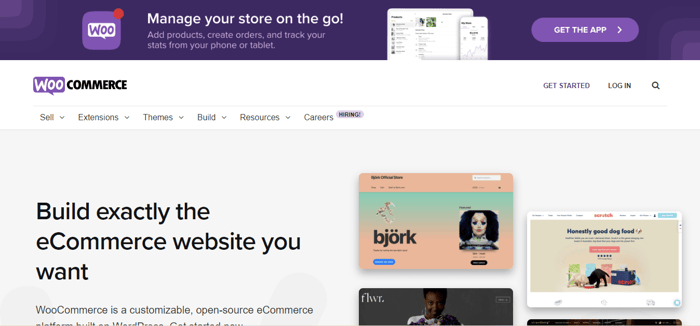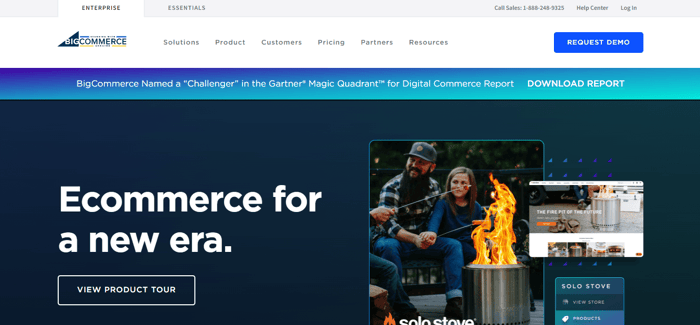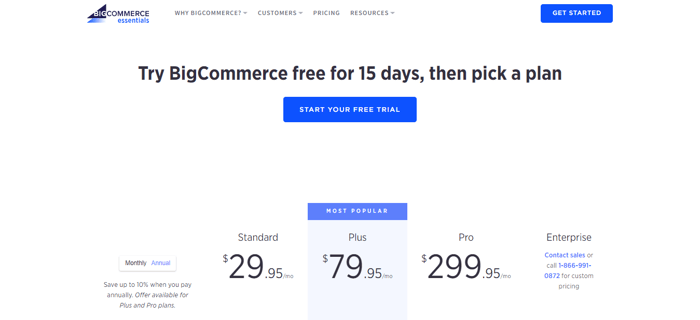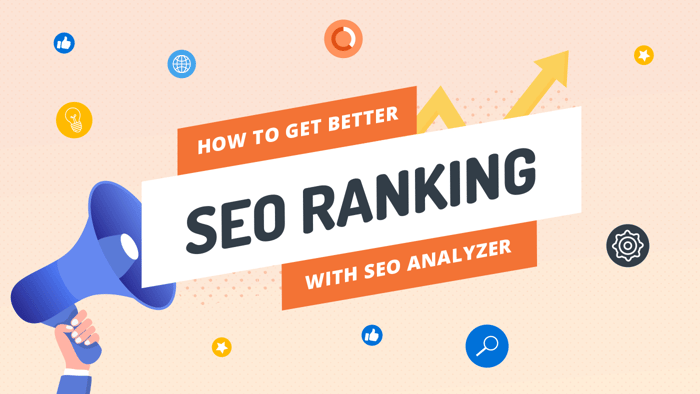WooCommerce vs. BigCommerce is a common comparison, but apart from the obvious difference of the former being a plugin and the latter being a platform, they perform very differently.
WooCommerce is an open-source e-commerce software that was built for WordPress. It’s a WordPress plugin whose purpose is to enable users to do e-commerce on a WordPress site. It’s the most popular e-commerce integration for WordPress.

On the flip side, BigCommerce is a stand-alone, highly-integrated e-commerce platform independent of WordPress. In addition, there’s a separate add-on for WordPress, appropriately called BigCommerce for WordPress.

So, on one hand, WooCommerce and BigCommerce can be viewed as different e-commerce solutions for WordPress. But, on the other hand, BigCommerce is much more than that; it has the advantage of also being self-contained e-commerce software. On top of this, while WooCommerce works exclusively with WordPress, BigCommerce is compatible with various content management systems and platforms.
Those are some of the substantial differences between the two. But, in this WooCommerce vs. BigCommerce comparison, we’ll explore much more than just their differences. We’ll also talk about whether they’re easy to use, their notable features, their price, and the customer support they provide. So, without further ado, let’s get to it!
Table of Contents
Ease of Use
It’s definitely easier to find your way around BigCommerce than WooCommerce. In this department, BigCommerce outperforms WooCommerce by a mile.
For starters, the WooCommerce setup process is pretty complex. You’ve got to take care of many things on your own: finding a hosting service, buying a domain name, configuring security and backups, etc. WooCommerce requires its users to be tech-savvy to a high degree.
In addition to this, with WooCommerce, you’ve got to install a whole bunch of additional add-ons to be able to run your e-commerce store as smoothly as possible. This can have an adverse effect in regard to speed, performance, and security. By using many integrations, you run the risk of slowing down your page load time, deteriorating your site/store performance, and making it more vulnerable to security threats.
In contrast, most of the functionalities needed for running an e-commerce store are built into BigCommerce. The platform takes care of hosting, SEO, payment, content, marketing ... virtually everything. Simply put, a highly or completely integrated platform makes things much smoother and more convenient.
Of course, as with any other e-commerce platform, there is a learning curve with BigCommerce too. But, you don’t exactly have to be Linus Torvalds (i.e., a genius software engineer) to figure out how to set things up and do e-commerce business on BigCommerce.
General Features
BigCommerce
BigCommerce offers a ton of features. Some of them are available with every plan, others only with the higher-tier plans.
Let’s have a look at a shortened list of noteworthy BigCommerce features:
No transaction fees
Unlimited inventory, storage, bandwidth, and staff accounts
POS (point of sale) integrations
The ability to sell on social media platforms like Facebook, Instagram, and Pinterest and marketplaces like Amazon, eBay, and Walmart
Mobile app
Drag-and-drop page builder/editor
Streamlined single-page checkouts
Various types of discounts, gift cards, and coupons
Product filtering
Analytics and reporting
Excellent SEO tools (for instance, the possibility to customize URLs to make them more SEO-friendly)
SSL certificates
Built-in DDoS protection and fraud detection
PCI compliance
A bunch of payment gateways
Abandoned cart recovery
Reliable hosting, exceptional uptime, and fast page load time
A ton of product configuration options
Akamai Image Manager (a built-in tool that optimizes image files for faster page load time)
A host of professional-looking, responsive and customizable themes (a small number of which are free, with the paid ones costing between $150 and $350)
A number of quality and secure apps and integrations in the BigCommerce app store
Limited options when it comes to customizability
A basic blog feature
WooCommerce
It’s tricky to talk specifically about WooCommerce features since, by its nature, it’s software that necessitates other software. This implies that many features that are built into other e-commerce platforms are only available as integrations on WooCommerce. But since there are features that come with WooCommerce out of the box, let’s have a look at what WooCommerce offers on its own.
WooCommerce includes:
WooCommerce Payments native payment gateway and a host of other payment processors like Stripe, PayPal, Google Pay, etc. (along with this, WooCommerce accepts credit cards and bank transfers)
Automated tax calculations
Ability to print labels and manage orders and shipments
Ability to sell both physical and digital products
Coupons, discounts, reward points, and gifts for your customers
WordPress blog
SEO tools
Upsells and cross-sells
Mobile app for iOS and Android
Multilingual store that supports various national currencies
Endless customization options
Unlimited inventory, orders, and customers
Real-time alerts of new sales
Analytics and statistical reports
Bulk editing of products
Email functionality
Countless e-commerce-related plugins (WordPress plugins or those made specifically for WooCommerce)
E-Commerce Features
BigCommerce
E-commerce features are what make or break an e-commerce store, so your chosen platform should excel on this front. And BigCommerce does. It comes with many vital features out-of-the-box and then some, which immediately relieves the need for third-party integrations, which also means fewer additional costs. Here’s some of what you get:
Multi-channel sales on BigCommerce allow you to sell directly on large online marketplaces like Amazon, eBay, and Walmart, as well as on social media such as Facebook and Instagram.
POS integrations allow you to integrate a variety of payment gateways, like Square, Vent, Clover, Hike, Ipos Now, and many others for online and offline syncing of your inventory and finance records.
Similarly, mobile payment services let you accept payments from Apple Pay, Google Pay, and Amazon Pay.
Abandoned cart emails on BigCommerce allow you to send automatic emails to customers who filled their cart but didn’t check out. It’s one of the best ways to recover profit that would’ve otherwise been lost.
Real-time shipping quotes enable you to give your customers accurate prices and real-time shipping rates for many major mail carriers around the world. Additionally, you can offer free shipping, in-store pickup, and next-day delivery.
Multi-currency pricing is pretty self-explanatory; the prices of your products can be displayed in over 100 currencies.
Using analytical and reporting tools, you’ll be able to keep track of how your business is performing by getting information about the sales, visitor metrics, order trends, customer groups, profits, and so on.
Product variants and product types on BigCommerce helps you branch out and sell physical, digital, and service-based products, making it the only platform on the market to do so right out of the box. Additionally, it makes adding different variants of the same product very easy compared to other similar platforms.
WooCommerce
Since WooCommerce is a self-hosted e-commerce solution, it relies on self-coded or paid extensions for its e-commerce features. That means you’ll be the curator of your features, and how functional your platform will be is entirely up to you.
This gives you a lot of freedom to handpick the extensions you’ll use, especially if you’re not limited by a budget. On the other hand, it can get overwhelming and time-consuming to the point where you get frustrated, so you should also keep that in mind.
Still, with WooCommerce, you can obtain some really good e-commerce functionalities. Since there are so many you can integrate, it’s difficult to grasp every single one. Here are some of them:
WooCommerce payments is a free plugin – WooCommerce’s own payment solution – designed to let you accept all major credit or debit cards and let your customers pay directly from your website. The best part is that it doesn’t have any setup costs or monthly fees, but so far, it’s only available in 18 countries.
Similarly, you can accept different payment methods. WooCommerce lets you integrate with over 100 payment gateways and other payment solutions for online and offline payment, including PayPal, Stripe, Square, Amazon Pay, AfterPay, Eway, and others.
With abandoned cart recovery emails, you can send automatic cart recovery emails (similar to BigCommerce), but, of course, you’ll need to integrate with an app to obtain this functionality.
Shipping management enables you to customize your customers’ shipping experience. WooCommerce offers a plethora of plugins to manage your inventory and shipping, from printing your own shipping labels with WooCommerce shipping, to setting shipping rates and prices, to offering different delivery options – it’s really all in which plugins you choose.
Business insights allows you to integrate with WooCommerce Sales Report Email to receive regular emails with insights on how your products are performing, and/or you can integrate with other plugins, such as Google Analytics, which is free, to obtain even more information.
Design and Templates
BigCommerce
Your storefront is what can attract or turn away a potential customer, and fortunately, BigCommerce has some really good-looking themes to offer. There are 12 free themes you can find on their theme store, which are all pretty functional and pleasing to the eye, even considering that they’re free.
If these don’t cut it, there are also over 100 paid themes, with prices varying from $150 to $350, which is on the pricey side compared to WooCommerce (and other e-commerce solutions), no matter how good and professional they look. However, you can get them for $99 when they’re discounted.

What we like about the BigCommerce themes is that they’re readily optimized for different types of businesses and needs, while the designs and layouts are far from repetitive. Plus, if you change your mind, you can always choose a new theme.
It should be noted, though, that they’re not as flexible when it comes to customization since there’s no coding involved. The customization interface is much like any business software solution, like Wix, for example. Of course, if you’re not code-literate, this will be an absolute positive.
However, the interesting thing is that BigCommerce launched a front-end framework called Stencil that provides a lot more in terms of aesthetics and customization options without coding.
WooCommerce
WooCommerce also does well when it comes to themes. It offers three free themes, which, admittedly, aren’t that visually amazing. However, considering that you can customize them by modifying the CSS/HTML, this isn’t a significant issue.

Other than that, there are around 40 paid themes with prices ranging between $39 and $129, which, as we said, is considerably cheaper than BigCommerce. Besides, if you don’t find anything you like among the theme selection offered on their site, there are many third-party theme stores that sell WordPress themes that support WooCommerce, like ThemeForest and TemplateMonster.
WooCommerce’s themes are pretty good and versatile. You can find great and affordable themes for many different industries, but as it goes for all open-source platforms, the more code-literate you are, the more you can make the best of your chosen theme.
Marketing and SEO
BigCommerce
Marketing and SEO are equally important for e-commerce businesses, which is why BigCommerce has many essential marketing and SEO built-in tools to help you increase your reach and conversion rates.
For one, your BigCommerce website will be mobile responsive, which is crucial for SEO, as a large part of website traffic comes from mobile phones. BigCommerce allows you to edit URL slugs, add image alt text, add keywords, and edit metadata. For more SEO functionalities, you can integrate with third-party apps.
Another thing we like is that with BigCommerce, you have built-in promotion tools for creating discounts, either via coupons and gift cards or other types of promotions (you have over 70 options, to be more precise).
Additionally, you can enable customer reviews and ratings to increase engagement and encourage communication. This is also useful because it gives you valuable first-hand information about how your products are performing.
Sending automated emails is another marketing practice that comes out of the box with BigCommerce. We already mentioned the abandoned cart recovery emails, but you can also automate sending promotional and informational emails.
Last but certainly not least, BigCommerce has a built-in blogging functionality. Having a blog to support your e-commerce business is a must nowadays. It’s one of the best SEO practices because it drives traffic to your website. The BigCommerce blog is nice and quite functional, but it’s basic. This shouldn’t come as a surprise since BigCommerce is primarily an e-commerce builder, so really, it’s enough that they included this functionality at all.
For more serious blogging, though, you can try DropInBlog. It’s an efficient and easy-to-use blogging tool that fits seamlessly into your theme and provides you with advanced blogging functionality. Plus, it takes no more than three minutes to integrate it into your site. Check out this short article on how to set up a blog on BigCommerce.
WooCommerce
WooCommerce is as flexible as it can be, and this is shown through the 160 marketing extensions available in their store. You can integrate with big-name apps like Trustpilot Reviews, Google Listings & Ads, Pinterest, MailPoet, and many others. In short, you’ll find apps to improve your SEO game, send automated promotional emails, create promotions and discounts, as well as advertise your products on different channels.
Being a WordPress plugin, WooCommerce makes creating a blog easy. All you need to do is add a blog post to your site straight from the WordPress Admin dashboard.
Lastly, what you should also consider is that, unlike BigCommerce, WooCommerce doesn’t provide you with a free SSL certificate, you’ll have to buy one in order to protect your customer’s sensitive information.
Plugins and Integrations
BigCommerce
Knowing how large a library WooCommerce has, BigCommerce’s app store holds up pretty well. It offers over 800 extensions spread across 21 categories, some of which include Accounting & Tax, Catalog & Order Management, CRM & Customer Service, Marketing, Mobile, Payments & Security, and others.
Although BigCommerce already comes with so many features out of the box, their app selection offered at the store can really elevate your website and make running your business much more manageable. There are both free and paid apps, the most popular of which are displayed on the homepage.
WooCommerce
WooCommerce is the champion of plugins, hands down. Since plugins and extensions are essential to make WooCommerce work, the developers have made sure to cover every and any need of the user. For some, this can be an advantage, as you literally have a smorgasbord of apps to choose from and assemble on your plate.
You’ll find a dizzying variety of apps in their store, both free and paid, across several categories, including Marketing, Payments, Store Management, Shipping, Delivery and Fulfillment, and others. There is a bundle of apps developed by WooCommerce themselves, most of which are free. For the paid apps, prices range from $30 to $250 per year.
Pricing
BigCommerce
BigCommerce offers three regular pricing plans, one custom enterprise-level plan, and a 15-day free trial.
These are the prices of the regular plans:
Standard: $29.95/month (billed either monthly or annually).
This plan enables you to start an online business by building an e-commerce store and gives you the basic tools to sell things and accept payments.
Plus: $79.95/month (monthly) or $71.95/month (annually).
This plan is suitable for a growing business, and it provides you with additional marketing tools for better lead-conversion rates.
Pro: $299.95/month (monthly) or $269.96/month (annually).
This plan helps you to go big and scale up by giving you access to advanced e-commerce features.

A big advantage of the BigCommerce pricing system is that there are no transaction fees with any of the pricing plans. No matter which payment processor you choose, BigCommerce doesn’t take a cut of your sales.
On the opposite end of the spectrum, a big downside is that BigCommerce automatically upgrades your account after you’ve reached a certain threshold of annual earnings. The earning limits that the company allows for the Standard, Plus, and Pro plans are $50K, $180K, and $400K, respectively.
So, for example, when you make more than $50,000 in sales, BigCommerce will upgrade your account without you necessarily agreeing to it. Many users find this to be a major inconvenience and drawback of the BigCommerce pricing system.
WooCommerce
You can install WooCommerce for free, but you need to be aware of and careful with all the additional costs.
As we already mentioned, if you decide to build your e-commerce store on WooCommerce, you have to buy hosting, an SSL certificate, various plugins, etc. Inevitably, the costs will add up really quickly.

On a yearly basis, hosting will cost you about $120. For a good or at least decent premium theme, add to this between $20 and $100 per year, as well as an additional $15 for a domain name.
If you decide not to use WooCommerce Payments and instead go with Stripe or any other third-party payment processor, there’ll be added fees per sale. These are the regular fees that third-party payment gateways take for their service (check out this WooCommerce source for details).
Finally, of all the integrations you’re going to need, the bulk will probably be paid. To be clear, there are many free add-ons for WooCommerce, but the paid ones give you much more in terms of functionality and options. So, for more serious and advanced stuff, you’ll hardly get by with free apps alone.
In the end, it turns out that doing e-commerce business on WooCommerce is not exactly cheap and definitely not free. Check out this article to find out more on the overall costs of running a store on WooCommerce.
Help and Support
BigCommerce
BigCommerce provides around-the-clock support via email, phone (US-based), and live chat – all available with every pricing plan.
In addition to this, there’s a Help Center, BigCommerce University, a Webinars page, BigCommerce Community, and a Knowledge Base.

Fast troubleshooting can be a deciding factor when it comes to the online business person who is not that tech-savvy. They just want to sell their products online, and technology should be a facilitator, not a hindrance to their business. In that sense, usability and practicality of the software are necessary qualities. And this is exactly what BigCommerce provides, along with superb technical support and customer help.
WooCommerce
With WooCommerce, things work differently. Due to the open-source nature of the software, there is no dedicated team of customer service staff that looks after its customers non-stop. To a great extent, you're on your own.
Searching for answers on forums and perusing the WooCommerce documentation is probably what you’ll end up doing most of the time. If you need more help than that, you can address your issues through the ticket system or make use of a third-party customer support app like WP Buffs. There’s also a support page where WooCommerce provides some useful information on how you can troubleshoot your e-commerce store issues.

In addition to this, due to your store being hosted on another platform and all the third-party apps installed, it’s likely that you’ll have to solve problems in more than one place. That might make things even more knotty from a support perspective.
This is not ideal since high-quality, easily accessible customer service is very important for businesses today. Clearly, BigCommerce beats WooCommerce’s support by a big margin. However, keep in mind that WordPress has an enormous community of users, many of whom are experts on the software. So, it shouldn’t be difficult to find someone who can help you with your specific WooCommerce store problems.
FAQs
What is the difference between WooCommerce and BigCommerce?
The difference between WooCommerce and BigCommerce is that the former is an open-source e-commerce plugin developed to run specifically on WordPress and turn your WordPress site into an e-commerce store. The latter is a self-sustaining e-commerce website builder with a built-in blogging functionality.
To elaborate further, being an open-source solution means that WooCommerce enables you to customize each part of your store if you know how to code. At the same time, it’s also a self-hosted solution, which means you’ll have to pay additionally for a hosting service, security, design, and domain name.
In contrast, BigCommerce is a fully-hosted platform with many built-in features that come out of the box. It has its own pricing plans that include a set of features and doesn’t require you to know code to customize your website.
What are the benefits of WooCommerce and BigCommerce?
There are many benefits to both WooCommerce and BigCommerce; it all depends on what you need as a business owner and what your budget is.
BigCommerce is a well-rounded, self-sufficient e-commerce solution that comes with many essential built-in features, which means that you won’t have to integrate with third-party apps to obtain some basic functionalities. It really offers you a lot right out of the box, including hosting, a domain name, and a free SSL certificate.
As BigCommerce works outside of WordPress, and because it runs on the Google Cloud platform infrastructure, the user experience stays intact even in situations when there are traffic surges or your e-commerce store needs to handle a massive amount of orders.
It’s also great for people who aren’t code-savvy because the website editor is pretty straightforward and very similar to other website editors out there, so there’s little you can do to go wrong with customization. Lastly, BigCommerce is very user-friendly, and there’s great customer support.
WooCommerce’s strong side is its customization range, which can be heaven for people who know CSS/HTML. It opens up many possibilities to customize your site and make it unique and, in this way, capture visitors’ attention. Besides, the fact that you must obtain all functionalities through integrations leaves you with the advantage of literally curating your store. They offer a wide selection of apps that can help you with marketing, shipping, SEO, product inventory management, back-office paperwork, and more.
What are the limitations of WooCommerce and BigCommerce?
No platform is perfect, so WooCommerce and BigCommerce naturally have some limitations.
For one, BigCommerce isn’t as flexible when it comes to customization, as its editor is slightly more rigid compared to WooCommerce. The biggest limitation, though, is that your pricing plan is determined on the basis of your revenue, which can be disadvantageous for stores with smaller margins.
WooCommerce’s limitations are its strengths – you need to be code-savvy in order to customize your store, and there’s a huge choice of apps to integrate with. The choice can not only be overwhelming, but it also incurs costs, as not all apps are free. Additionally, WooCommerce has a learning curve, and it’s not as easy to use as BigCommerce. Lastly, being an open-source platform means there is no dedicated support.
Do big e-commerce stores use WooCommerce, BigCommerce, or Shopify?
WooCommerce, BigCommerce, and Shopify are the three e-commerce giants that are dominating the market, with Shopify firmly holding its position at the top. However, BigCommerce is Shopify’s closest competitor of its kind, while WooCommerce is the most widely used e-commerce plugin since WordPress powers the majority of all websites.
With that being said, many big websites use these three e-commerce solutions. Let’s see some of them:
WooCommerce:
MinimalistBaker (also seen on our highest paid food bloggers list)
BigCommerce:
Shopify:
Does BigCommerce use WordPress?
Yes, as we mentioned earlier, BigCommerce has developed a plugin that works with WordPress which you can find here.
Can I use WooCommerce without WordPress?
WooCommerce is an e-commerce plugin developed for WordPress rather than an e-commerce platform, which means that you need to have a WordPress site in order to use WooCommerce. In other words, it’s a plugin meant to add e-commerce functionality to your WordPress website, and it can’t be used on its own.
How do BigCommerce and WooCommerce compare to Shopify?
BigCommerce is Shopify’s closest competitor, but that doesn’t mean they are the same. For example, Shopify is great for larger businesses because it can grow with you, but there is an upper limit that’s not there with BigCommerce.
In contrast, BigCommerce is best suited for very large e-commerce businesses because it allows you to scale. On the other hand, smaller businesses can’t really do well with BigCommerce because they’ll be paying for features they won’t need.
WooCommerce is more flexible than Shopify in many ways considering that it’s open-source software. Technically, with WooCommerce, you can obtain similar functionalities to Shopify, but Shopify’s prices are much more affordable, and it comes with some really good built-in features.
Simply put, Shopify’s pricing plans are well-built to enable you to streamline your business and build a very nice online store. Plus, you have excellent 24/7 support. You can read more in our WooCommerce vs. Shopify comparison.
Final Thoughts
BigCommerce is much more efficient in what it does when compared to WooCommerce. It seems to be a more solid and stable e-commerce platform.
On the other hand, WooCommerce offers a lot more customization and a plethora of free add-ons. Also, when it comes to costs, it may be the cheaper option out of the two, especially if you take a really economical approach to e-commerce (free plugins, free integrations, free themes, cheap hosting, and so on).
You may be a fan of WordPress and want your e-commerce store built on that platform. That’s cool. But if research and this BigCommerce vs. WooCommerce comparison shows anything, it’s that there are other great solutions out there too, like BigCommerce for e-commerce and DropInBlog for blogging. So, why don't you try them out?




